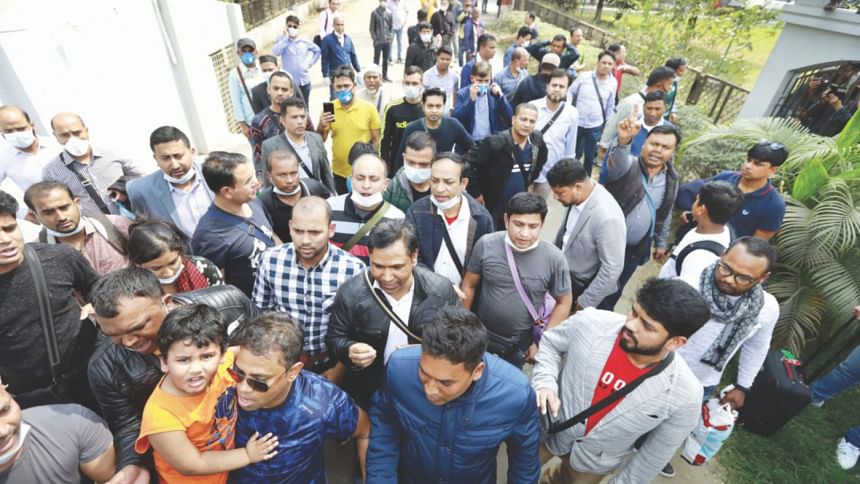Can quarantine be a solution in a country like Bangladesh?

The words "quarantine" and "isolation" have now become synonymous with the coronavirus outbreak. Social media has exploded with status updates, pictures and videos related to "self-quarantine"; some poking fun at the absurdity of it all, while others are more optimistic, highlighting how we should use this opportunity to spend much-needed quality time with our parents, spouses or children, and take a breather from our fast-paced, robotic lives. I couldn't agree more with the latter.
It has been interesting, to say the least, to see how the pandemic has been unfolding in Bangladesh in particular. As a people living in a country that is in perpetual crisis mode (natural disasters, mosquitoes, onion prices, you name it), we are used to putting up a brave face and weathering the storm—whatever it may be.
But the novel coronavirus has put us in a wholly unchartered territory. We haven't quite seen anything like it before. Unlike other more "familiar" viral infections like dengue—caused by a visible carrier of the disease, i.e. mosquitoes—COVID-19 transmission is invisible to the naked eye.
Much like the virus itself, the preventive measures for COVID-19 too are unheard of, and even unthinkable, for us Bangladeshis—particularly the concept of "quarantine". It raises the important question: how realistic and effective is "quarantine" in the context of Bangladesh in tackling COVID-19?
It's highly likely that the term itself is completely alien to a huge proportion of the population, let alone having adequate knowledge about what "quarantine" means and entails. Many are already expressing scepticism about the viability of quarantines in Bangladesh, given the fact that some migrants have blatantly violated instructions to keep themselves in isolation and at least two men in Dhaka and Brahmanbaria have escaped hospitals.
More than 2,000 people are in home quarantine, and at least 42 in institutionalised quarantine, according to the Institute of Epidemiology, Disease Control and Research (IEDCR). It is not clear on what basis or criteria the cases of home and institutionalised quarantines have been differentiated. But it seems that those showing symptoms of COVID-19 have been put in institutionalised isolation and those who have returned from COVID-19-affected countries, among others, have been told to remain in self-isolation.
It is understandable why health authorities are urging people to stay at home. They are rightly focusing on prevention. Because should the number of infected patients who will need to be institutionally quarantined increase greatly, our overburdened healthcare system will simply not be able to cope. But when it comes to home quarantine, or self-isolation or self-quarantine—whatever you want to call it—there are a number of reasons why it might not be as effective in Bangladesh, compared to many other countries.
Firstly, the option of home quarantine is itself a luxury for most. Think of the farmers, the part-time housemaids, the rickshaw-pullers, the roadside tea stall owners. For these groups of people, stepping outside the home is a necessity if they are to put food on the table. For them, not only is the concept of "home quarantine" unintelligible, but also akin to financial suicide.
Secondly, has anyone at the policy level thought about what home quarantine would look like for slum-dwellers, who make up around 40 percent of Dhaka's population? How does "home quarantine" fit into the picture of the capital's sprawling, overcrowded slums, where families are cramped in single rooms, and live in the most unhygienic conditions?
It's obvious that urban slums are a safe haven for infectious diseases like COVID-19. The structure and conditions of these slums make "home quarantine" in these spaces an impossibility. But it seems that in the media and political circles alike, slum-dwellers and the lower economic strata in general have conveniently been overlooked. Some news outlets have the following tips related to home quarantine: "watch a movie, listen to music or read a book". Slum-dwellers are clearly not even part of the conversation.
Thirdly, home quarantine is self-enforced. This means it is up to us, as individuals (those of us who can afford the luxury of staying at home), to remain indoors and maintain "social distancing". But some have unsurprisingly taken it upon themselves to utilise this opportunity to go on family vacations. Hundreds of tourists reportedly flocked to Cox's Bazar from different districts following the closure of educational institutions. As a result, authorities in Cox's Bazar and Chattogram rightly banned public gatherings at beaches on March 18.
The element of "self-enforcement" in "home quarantines" can be misleading, ineffective and even dangerous, when we are dealing with a population that severely lacks health literacy and has a general neglect for wellbeing and personal hygiene. The concept of preventive measures is alien even to a large chunk of the middle class in Bangladesh, as the Cox's Bazar episode shows.
With the exception of the minority of urban elites, who have the awareness and financial stability to choose to stay home, home quarantines are not appealing or realistic for the majority of the population.
Putting aside the economic factor and our general negligence towards public health, there is an important social element we simply cannot overlook. We are a breed that revels and thrives in mass gatherings—be it big weddings, joint families, festivals or public holidays. The need for social gatherings is engrained in our collective DNA. But quarantines require of us the exact opposite. One cannot expect millions of people—especially those who do not possess the requisite educational literacy and health awareness—to suddenly exhibit behavioural change.
The truth is that the very idea of "quarantine" goes against the social nature of human beings. As Neil MacFarquhar astutely points out in an article in the New York Times, quarantines have historically exposed the conflicts between public health and individual rights.
If there is one thing that the coronavirus pandemic has made clear, it is that there are countless complexities in containing infectious diseases in populations. It, once again, goes to show why people-centred development—investing in quality education and health and closing the gap between the rich and poor—is crucial for the prevention of public health catastrophes.
Nahela Nowshin is a graduate student of development studies. The views in this article are of the author alone, and do not represent those of any organisation(s) she is affiliated with.

 For all latest news, follow The Daily Star's Google News channel.
For all latest news, follow The Daily Star's Google News channel. 



Comments